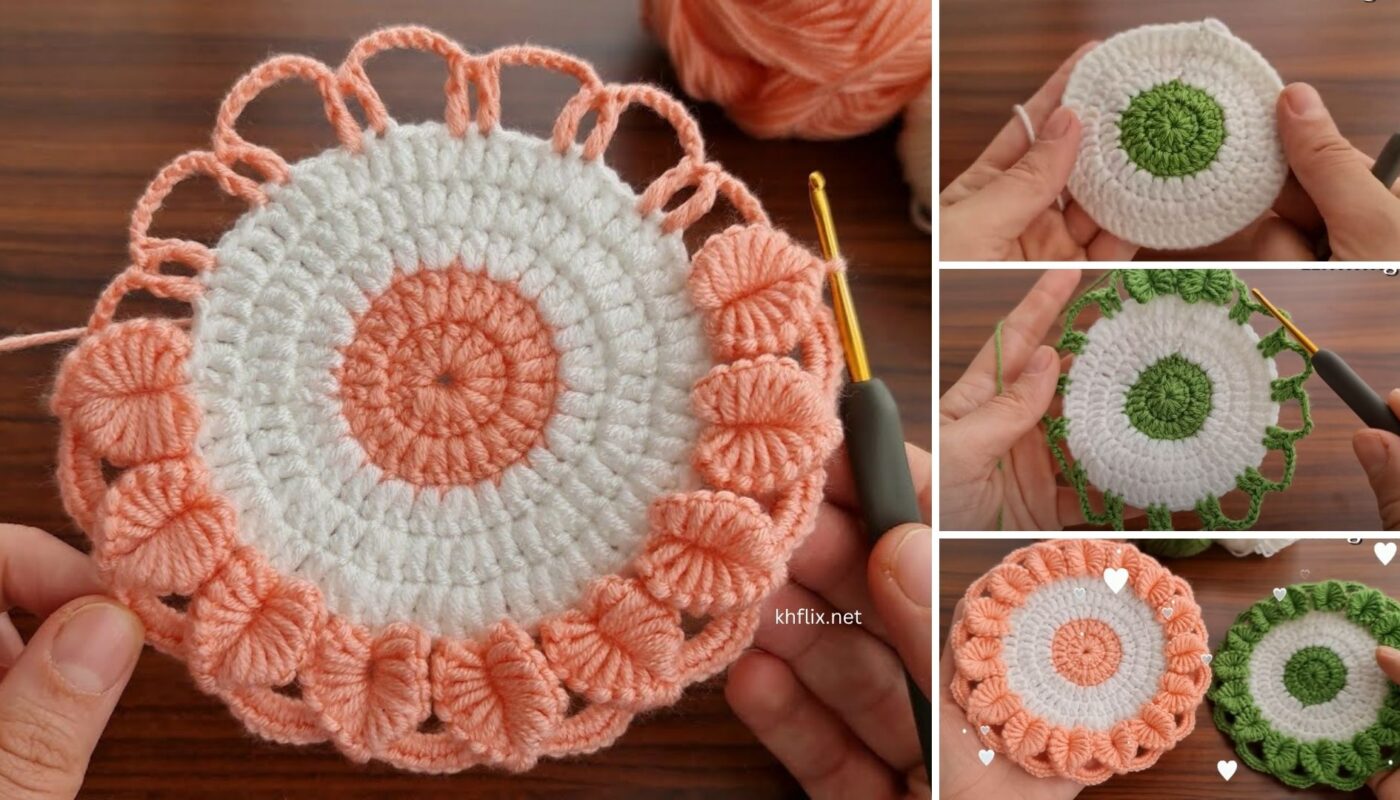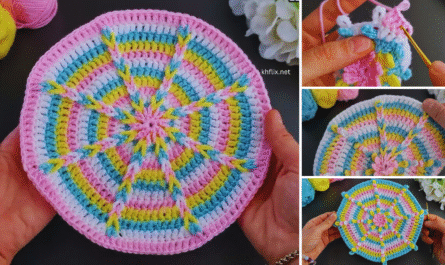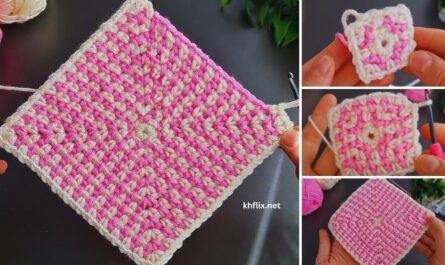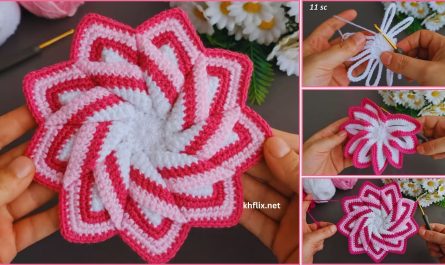That’s a fantastic idea! A beautiful crocheted flower coaster is not only functional but also adds a lovely decorative touch to any table. For a coaster, we want something relatively flat, sturdy, and absorbent. Cotton yarn is highly recommended for this purpose due to its absorbency and heat resistance.
Let’s make a beautiful, sturdy flower coaster!

Pattern: Beautiful Crochet Coaster Flower
This tutorial will guide you through creating a charming and functional flower-shaped coaster. It’s designed to be sturdy enough for holding drinks while still featuring distinct petal-like edges.
Goal: To crochet a flat, durable, and aesthetically pleasing flower-shaped coaster, approximately 4-5 inches in diameter.
Materials You’ll Need:
- Yarn:
- 100% Cotton Worsted Weight (Medium #4) Yarn: This is crucial for coasters as it’s absorbent and heat-resistant. Acrylic yarn can melt under hot mugs.
- Choose your desired Yellow color (or any other color for your petals).
- Optional: A small amount of a contrasting color for the center, or green for optional leaves (though for a coaster, a solid flower might be more practical).
- Crochet Hook:
- Size H/5.0mm (or a size that gives you a dense, flat fabric with your chosen cotton yarn).
- Yarn Needle (Tapestry Needle): For weaving in ends.
- Scissors
- Stitch Marker (Optional, but helpful): To mark the beginning of rounds.
Abbreviations Used:
- ch: chain
- sl st: slip stitch
- sc: single crochet
- hdc: half double crochet
- dc: double crochet
- tr: treble crochet (or triple crochet)
- st(s): stitch(es)
- sp: space
- ch-sp: chain space
- MR: magic ring (or magic circle)
- FO: fasten off
- BLO: back loop only
Understanding the Coaster’s Structure
This flower coaster will be worked in the round, building from the center outwards. We’ll create a solid base and then add “petals” that form the decorative edge. The goal is flatness and density for coaster functionality.
- Round 1 (Center Base): A compact starting circle.
- Round 2 (Expanding Base): Increase stitches to create a flat, growing circle.
- Round 3 (Establishing Petal Base): Create a foundation for the distinct petals.
- Round 4 (Petals): Work the decorative petals.
- Round 5 (Outer Border/Stabilizer): An optional final round to firm up the edge and add a finished look.
Let’s Start Crocheting!
We’ll use Yellow Yarn predominantly, but you can use a different color for the center base (Round 1 & 2) if you prefer.
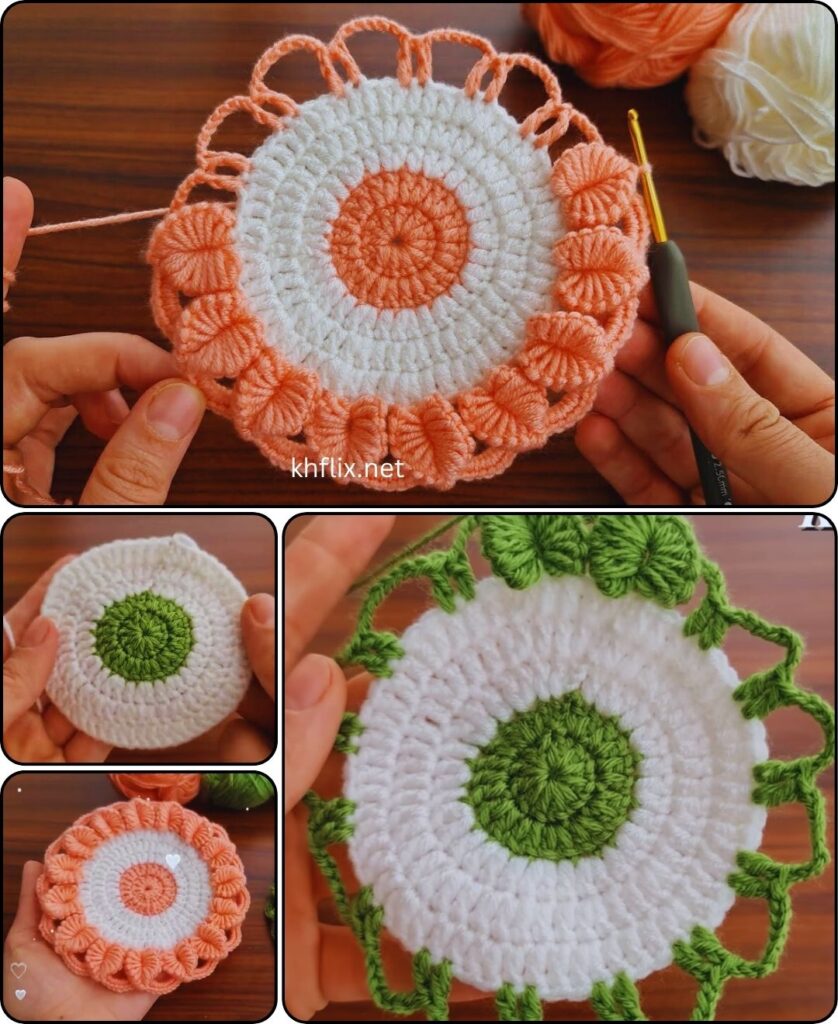
Part 1: The Coaster Base (Yellow Yarn or Contrasting Color)
We need a solid, flat center for the cup to rest on.
Option A: Chain Ring (Beginner Friendly)
- With Yellow Yarn (or contrasting color), ch 4.
- Sl st into the first chain you made to form a ring.
Option B: Magic Ring (Tighter Center – Recommended for no hole)
- With Yellow Yarn (or contrasting color), create a Magic Ring.
- Ch 1 (does NOT count as a stitch, just secures the ring).
Round 1 (Center Base – continued):
- Into the center ring (from Option A or B), ch 1 (does not count as a stitch).
- Work 10 sc (single crochet) into the center ring.
- Sl st into the first sc to join the round. (10 sc).
- If using Magic Ring, pull the tail tight to close the center hole.
- If you used a contrasting color for the center, FO here and weave in ends. Then join Yellow Yarn for Round 2.
Round 2 (Expanding Base):
- Ch 1 (does not count as a stitch).
- Work 2 sc into each sc around. (20 sc).
- Sl st into the first sc to join the round.
- You should now have a flat, solid circle approximately 2 inches in diameter.
Part 2: Establishing the Petal Base (Yellow Yarn)
This round creates the framework into which our decorative petals will be worked.
- Ch 1 (does not count as a stitch).
- Work 1 sc in the first st.
- Ch 3.
- Skip 1 st.
- Sc in the next st.
- You are creating a [sc, ch 3, skip 1] pattern around the circle.
- Repeat steps 3-5 around. You should end with a ch 3 and then sl st into the first sc of the round to join. (10 sc, 10 ch-3 spaces).
- This round will look a bit “bumpy” or “loopy” – this is normal! These ch-3 spaces are where your petals will go.
Part 3: Crocheting the Petals (Yellow Yarn)
Now for the beautiful petals! We’ll work groups of stitches into each ch-3 space.
- Sl st into the first ch-3 space to position your hook.
- Round 4 (Petals):
- Ch 2 (counts as first hdc).
- Work 4 hdc into the same ch-3 space. (Total 5 hdc, including ch 2).
- Sl st into the next ch-3 space.
- (This completes your first petal. It’s a full, rounded shape).
- Repeat the following 9 more times (for a total of 10 petals):
- Ch 2.
- Work 4 hdc into the same ch-3 space.
- Sl st into the next ch-3 space.
- After your 10th petal, sl st into the initial sl st you made at the very beginning of this round (the one you used to enter the first ch-3 space).
- FO Yellow Yarn, leaving a tail to weave in.
- You should now have a beautiful, flat flower shape with 10 distinct petals forming the edge of your coaster!
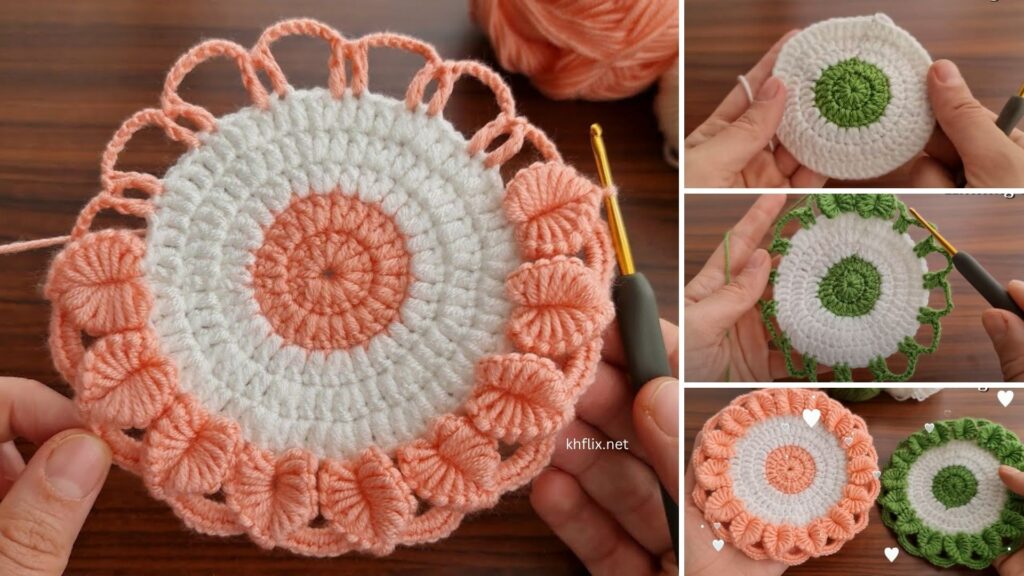
Part 4: Optional Outer Border/Stabilizer (Yellow Yarn or Contrasting Color)
This round helps to firm up the edge and give the coaster an even more polished look.
- Join Yellow Yarn (or a contrasting color) with a sl st into any sl st between two petals from Round 4.
- Round 5 (Border):
- Ch 1 (does not count as a stitch).
- Work 1 sc in the same sl st.
- Work 1 sc into each of the 5 hdc stitches of the first petal.
- Work 1 sc into the sl st between the current petal and the next petal.
- Repeat this pattern around the entire coaster. (You’ll be working 1 sc into each hdc of the petals and 1 sc into each sl st between petals).
- Sl st into the first sc to join the round.
- FO, leaving a tail to weave in.
Finishing Your Beautiful Crochet Coaster Flower
- Weave in All Ends: This is crucial for a neat and durable coaster.
- Thread each yarn tail onto your yarn needle.
- Carefully weave the tail through several stitches on the back of your coaster, making sure it’s secure and doesn’t show through.
- Trim any excess yarn close to the fabric.
- Blocking (Recommended for Flatness):
- Gently wet your coaster (or spray it with water until damp).
- Pin the coaster flat onto a blocking mat or a towel-covered surface, gently stretching it to its desired flat, round shape. Make sure the petals are evenly spaced.
- Let it air dry completely. Blocking makes a huge difference in how professional and flat your coaster looks.
Tips for Beginners:
- Cotton Yarn is Key: Don’t substitute acrylic if you want a functional coaster that can handle hot mugs.
- Gauge/Tension: Aim for a relatively tight tension so your coaster is dense and sturdy, not too floppy. If it’s too loose, go down a hook size.
- Counting Stitches: Always count your stitches at the end of each round to ensure your coaster grows evenly and stays flat.
- Identifying Stitches/Spaces: In Round 3, finding the “ch-3 spaces” is straightforward. In Round 4, ensuring you work into the “next ch-3 space” (not an actual stitch) is important for the petal formation.
- Video Tutorials: If you’re unsure about any stitch (hdc, dc) or technique (Magic Ring, joining rounds), search for video tutorials online.
- Make a Set! These coasters look gorgeous in sets. Experiment with different shades of yellow, or create a rainbow of flower coasters!
Enjoy making your beautiful crochet flower coaster! They make wonderful gifts too.

